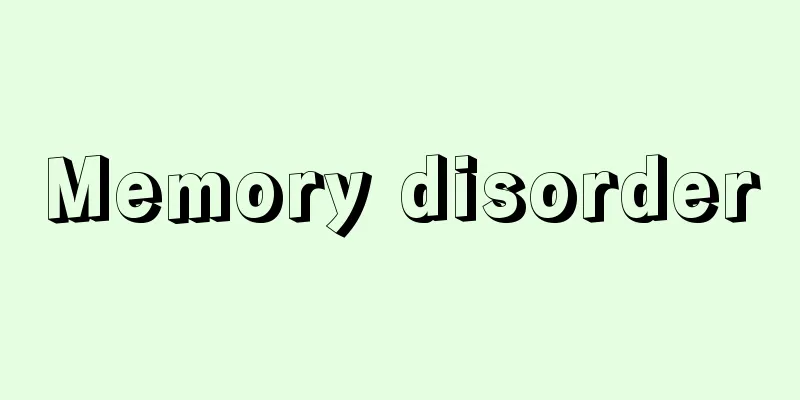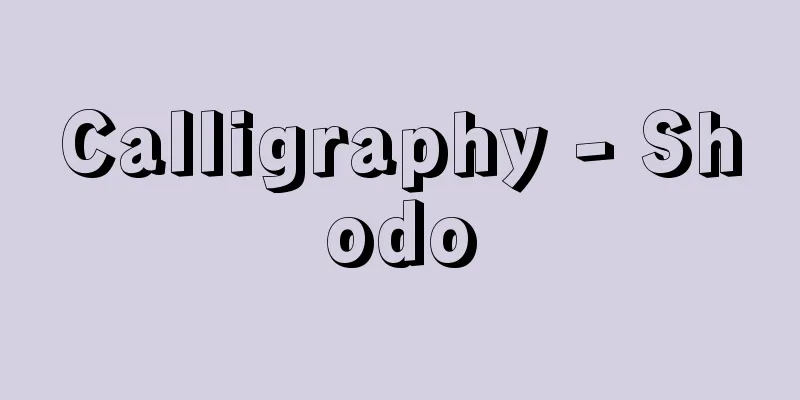Memory disorder

|
Memory is essential for our daily lives, and memory impairments impair our lives in many ways. Research into the mechanisms of human memory from memory impairments associated with brain damage and neuropsychiatric disorders has developed in the academic field of neuropsychology, and many facts have been clarified through various experimental studies. There are a wide variety of diseases that cause memory disorders, but the main pathologies in which a decline in memory function is the main cause of the disorder are amnesia and dementia. The difference between the two is that in amnesia, only memory disorders are observed, whereas in dementia, memory disorders tend to be prominent, but other higher cognitive functions such as language, attention, thinking, and problem solving also decline overall. Amnesia can be further divided into organic amnesia and psychogenic amnesia. The former is caused by brain damage, which results in amnesia symptoms, whereas the latter is basically caused by mental stress without any significant brain damage. The latter is sometimes called functional amnesia because it impairs mental function. Relatively common types of organic amnesia include (1) temporal lobe amnesia (pure amnesia) caused by damage to the medial temporal lobe (hippocampus and surrounding areas), (2) Korsakoff syndrome caused by damage to the mammillary bodies or dorsomedial thalamic nucleus, (3) basal forebrain amnesia caused by damage to the basal forebrain, (4) thalamic amnesia caused by damage to the thalamus, and (5) retrosplenial amnesia caused by damage to the posterior splenial part of the corpus callosum, located at the back of the brain. Of these, there are many cases of ⑴ to ⑶, and a considerable number of studies have been conducted on these diseases. ⑴ is caused by herpes encephalitis and anoxia, and in many cases, tissues, especially the hippocampus, are damaged on one or both sides, which causes memory impairment. In general, amnesia is more severe in bilateral damage than in unilateral damage. ⑵ is caused by Wernicke's encephalopathy, which develops against the background of vitamin B1 deficiency due to continuous drinking or visceral disease. Severe amnesia is presented as an aftereffect of Wernicke's encephalopathy. ⑶ is caused mainly by damage to the basal forebrain due to rupture of anterior communicating artery aneurysm (subarachnoid hemorrhage). Among ⑴ to ⑸, ⑶ has the highest incidence rate, and although there are individual differences, severe memory impairment is often observed as an aftereffect. In organic amnesia, the quality and degree of memory impairment varies depending on the site of damage, but there are some relatively common characteristics. These include: 1) there is no significant impairment of short-term memory or procedural memory, and intelligence and language are within the normal range; 2) anterograde amnesia, which is memory impairment for new events that occurred after the onset of the amnesia, is observed; 3) retrograde amnesia, which is memory impairment for events that occurred before the onset of the amnesia, is observed; and 4) in retrograde amnesia, there is a temporal gradient in which the further back in time one goes, the more information can be recalled (Figure). All of these findings were discovered using psychological techniques. The aforementioned feature of "no significant impairment of short-term memory" was clarified by Scoville, WB and Milner, B. (1957) from a series of experiments on HM, a case of memory impairment. After undergoing resection of the medial temporal lobes and surrounding areas for the treatment of epilepsy, HM showed severe anterograde amnesia and was unable to retain information for even a few minutes, despite his intelligence, language, knowledge, digit span, and procedural memory all being within normal ranges. This shows a discrepancy between HM's long-term memory being impaired and his short-term memory being relatively well preserved, and provides evidence in support of the two-store memory model. In addition to this, research data on memory impairment has played a major role in improving the validity of concepts and classifications of memory in cognitive psychology, such as the classification of implicit memory and explicit memory. On the other hand, it is difficult to grasp the symptoms and characteristics of psychogenic amnesia (functional amnesia) through experimental approaches compared to organic amnesia. What is unique about psychogenic amnesia is that the information that cannot be remembered is limited to personal events, so to speak, autobiographical memory, while the ability to recall events that are not closely related to the individual and general knowledge is relatively preserved. The time gradient observed in organic amnesia is not observed in psychogenic amnesia. While there are many cases where there is no significant problem with the ability to remember new things, there is a large individual difference in whether or not the forgotten information can be recovered to the point of being able to be recalled again. In some cases, almost all memories, including traumatic events, are recovered soon after the onset of the disease, while in other cases, personal memories are not restored even after many years have passed. In some cases, memories of pre-morbid personality, habits, and hobbies are lost, which can often lead to panic in daily life or cause personality changes. Although research has progressed, the neural mechanisms behind psychogenic amnesia are still not fully understood. In recent years, with the technological development of functional brain imaging such as functional magnetic resonance imaging (fMRI), research on the neural mechanisms of memory in healthy subjects has been actively conducted. For example, the function of the medial temporal lobe, where HM was damaged, has been elucidated from various aspects, such as information encoding and retrieval, as well as consciousness in these activities, through experiments using experimental psychology techniques. In these imaging studies, the experimental design is devised based on a series of results revealed in research on memory disorders. In addition, knowledge gained from imaging studies on healthy subjects is also useful for elucidating the symptoms of memory disorders and rehabilitation. Thus, experimental research on healthy subjects and case studies on memory disorders are not mutually exclusive, but rather the two are currently developing together. →Memory →Temporal association area →Limbic system →Dementia [Umeda Satoshi] "> Figure: Temporal gradient of recall amount in memory disorders Latest Sources Psychology Encyclopedia Latest Psychology Encyclopedia About Information |
|
記憶memoryは,われわれの日常生活にとって必要不可欠であり,記憶に障害があると,さまざまな面で生活に支障を来す。脳損傷や精神神経疾患に伴う記憶障害から,人間の記憶メカニズムを探ろうという研究は,神経心理学neuropsychologyという学問分野で発展しており,さまざまな実験的研究から多くの事実が明らかにされてきた。 記憶の障害を呈する疾患は多岐にわたるが,記憶機能の低下が障害の中心となる主な病態としては,健忘症amnesiaと認知症dementiaが挙げられる。両者の違いは,健忘症では基本的に記憶の障害のみが認められるのに対して,認知症では記憶の障害が前面に現われやすいものの,言語,注意,思考,問題解決といった他の高次認知機能も全般的に低下することにある。 健忘症はさらに,器質性健忘organic amnesiaと心因性健忘psychogenic amnesiaに分けられる。前者は脳に障害があり,それが原因で健忘症状が現われるのに対し,後者は基本的には脳に顕著な障害は認められず,心的ストレスなどを原因として発症する。精神機能が損なわれるという見方から,後者は機能性健忘functional amnesiaとよばれることもある。器質性健忘で比較的多く観察されるのは,⑴側頭葉内側部(海馬とその周辺部位)の損傷を伴う側頭葉性健忘temporal amnesia(純粋健忘pure amnesia),⑵乳頭体や視床背内側核などの損傷を伴うコルサコフ症候群Korsakoff syndrome,⑶前脳基底部の損傷を伴う前脳基底部健忘basal forebrain amnesia,⑷視床の損傷を伴う視床性健忘thalamic amnesia,⑸脳の後部に位置する脳梁膨大後部の損傷を伴う脳梁膨大後部健忘retrosplenial amnesiaなどである。 このうち,⑴~⑶については症例数も多く,これらの疾患を対象とした研究も相当数に及んでいる。⑴の原因となるのは,ヘルペス脳炎herpes encephalitisや無酸素症anoxiaなどであり,片側あるいは両側の海馬を中心とした組織が損傷を受けるケースが多く,それが原因となって記憶障害が現われる。一般に,片側損傷よりも両側損傷において,健忘の程度が重篤である。⑵の原因となるのは,ウェルニッケ脳症Wernicke's encephalopathyであり,連続飲酒や内臓疾患などに伴うビタミンB1の欠乏を背景として発症する。ウェルニッケ脳症の後遺症として,重度の健忘症状が呈される。⑶の原因となるのは,主に前交通動脈瘤の破裂(クモ膜下出血)に伴う前脳基底部の障害である。⑴~⑸の中では⑶の罹患率が最も高く,個人差はあるものの,後遺症として重篤な記憶障害が認められる場合が多い。 器質性健忘においては,損傷部位によって記憶障害の質や程度に違いがある一方,比較的共通して見られる特徴も存在する。それは,①短期記憶や手続き記憶の障害は顕著でなく,知能や言語なども正常範囲内である,②発症後に起こった新しい事象についての記憶障害である前向健忘anterograde amnesiaが認められる,③発症前に起こった出来事についての記憶障害である逆向健忘retrograde amnesiaが認められる,④逆向健忘において,過去にさかのぼるほど想起できる情報量が増える時間的傾斜temporal gradientが認められる,などである(図)。これらの知見は,いずれも心理学的な手法を用いて発見されたものである。 前述①の「短期記憶に顕著な障害がない」という特徴は,スコビルScoville,W.B.とミルナーMilner,B.(1957)によって,記憶障害を呈する症例H.M.に対する一連の実験結果から明らかにされた。H.M.は,てんかんの治療を目的とした両側側頭葉内側部とその周辺部位の切除術を受けた後,知能・言語・知識・数唱,および手続き記憶がそれぞれ正常範囲内であったにもかかわらず,重度の前向健忘を示し,数分間情報を保持することすらできなくなった。このことは,H.M.の長期記憶が障害を受けている一方,短期記憶は比較的保たれているという乖離を示しており,二重貯蔵モデルtwo-store memory modelを支持する証拠となった。これに限らず,潜在記憶implicit memoryと顕在記憶explicit memoryの分類など,認知心理学で取り上げられる記憶の概念や分類の妥当性を高めるうえで,記憶障害を対象とした研究データは大きな役割を果たしてきた。 他方,心因性健忘(機能性健忘)は,器質性健忘と比べ,実験的なアプローチによってその症状や特徴をとらえるのが困難である。心因性健忘で特異的なのは,思い出せない情報が個人的な出来事,いわば自伝的記憶autobiographical memoryに限られており,個人と関連性が高くない出来事や一般的な知識の想起能力は比較的保たれることである。器質性健忘で観察される時間的傾斜は,心因性健忘では認められない。新しいことを覚える能力には大きな問題がないケースが多い一方,忘れてしまった情報を再度想起できるほどに回復するか否かには大きな個人差があり,発症後まもなくトラウマとなった出来事を含め,ほとんどすべての記憶が取り戻されるケースもあれば,何年経過しても個人に関する記憶が戻らないケースもある。中には,病前の性格や癖,嗜好品に関する記憶まで失われ,日常生活においてしばしばパニックに追い込まれたり,人格の変化を生じさせたりする場合もある。心因性健忘の背後にある神経メカニズムに関しては,研究の進歩はあるものの,いまだ十分な理解に至っていないのが現状である。 近年は,機能的磁気共鳴画像(fMRI)など,脳機能画像法の技術的発展に伴い,健常者を対象とした記憶の神経メカニズムを探る研究も盛んに行なわれている。たとえば,H.M.が損傷を受けていた側頭葉内側部についても,情報の符号化や検索をはじめ,それらの活動における意識性など,さまざまな側面から実験心理学的な手法を用いた実験によって機能の解明が進められている。これらの画像研究では,記憶障害の研究から明らかにされた一連の成果を踏まえて実験デザインが考案されている。また,健常者を対象にした画像研究から得られた知見が,記憶障害の症状の解明やリハビリテーションにも役立てられている。このように,健常者を対象とした実験的研究と記憶障害を対象とした症例研究は相対するものではなく,両者が融合して発展しているのが現状である。 →記憶 →側頭連合野 →大脳辺縁系 →認知症 〔梅田 聡〕 "> 図 記憶障害における想起量の時間的傾斜 出典 最新 心理学事典最新 心理学事典について 情報 |
Recommend
Lessivage - Lessivage
One of the basic soil formation processes, it is a...
Payer - Shiharainin (English spelling) drawee
A person designated by the issuer to pay the bill ...
Dry transition series - Dry transition series
...the phenomenon in which the composition of a b...
Kana Kagiya - Keyakizaka
The creator of Iyo Kasuri. Born to a farmer in Im...
Otono - Otono
〘Noun〙[一] "O" is an honorific title. &qu...
Han Huang - Travel
A Chinese government official in the middle Tang ...
Hadley, J.
…It was based on the same optical principles as t...
Gastrointestinal system
A collective term for the digestive and circulato...
Mecopoda elongata (English spelling) Mecopodaelongata
…[Yamazaki Harane]. … *Some of the terminology th...
Garhepiggen [mountain] - Garhepiggen
The highest point in Scandinavia, the Jotunheimen ...
Katsurame
These women peddled sweetfish, uruka (sweetfish i...
OAS - Open Air System
《 Organization of American States 》⇒Organization o...
Employment policy
A policy to prevent unemployment and ease employme...
Stress relief annealing - Stress relief annealing
…Thermo-mechanical treatment, which combines plas...
Cassia fistula (English spelling)
…[Mitsuru Hotta] [Aya Nitta]. … *Some of the term...









